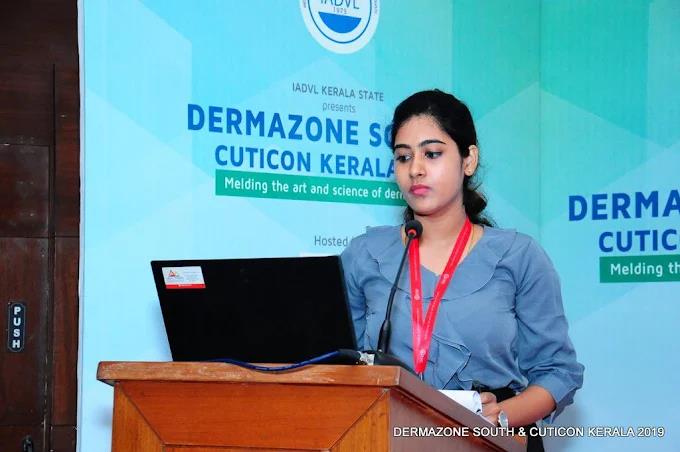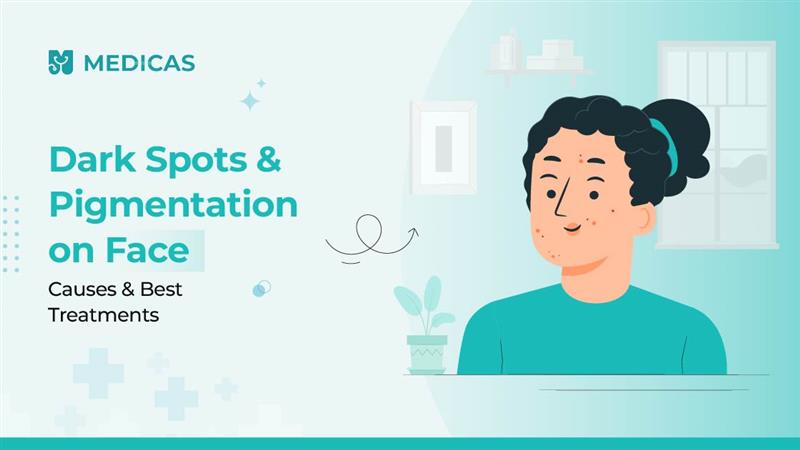For many people, especially those with melanin-rich skin tones like ours in India, dark spots and facial pigmentation can be more than just a cosmetic concern; they can be a source of deep personal insecurity. I’ve seen patients walk into my clinic hiding behind layers of makeup, avoiding mirrors, or skipping social events because they feel their skin doesn’t reflect who they truly are. As a doctor who see patients daily, I understand how emotionally challenging these concerns can be. Pigmentation issues don’t just affect how we look, they affect how we feel about ourselves. The good news? There is hope, and there are solutions. Whether you’re dealing with stubborn acne marks, sun spots, melasma, or post-inflammatory hyperpigmentation, this guide will help you understand why they occur and what you can do to treat and prevent them safely and effectively. Your journey to clearer, more confident skin starts here.
So, what Is Pigmentation on the Face?
Pigmentation refers to the colouring of your skin. It’s caused by melanin, a pigment produced by cells called melanocytes. When these cells become damaged or unhealthy, they can overproduce melanin, leading to hyperpigmentation treatment which manifests as dark spots on face. Conversely, if too little melanin is produced, it can result in hypopigmentation, causing lighter patches. Here, we’ll focus on hyperpigmentation treatment, which is responsible for those pesky dark spots.
Types of Pigmentation: Melasma, Freckles, and PIH
Several types of pigmentation can affect the face, each with its unique characteristics:
- Melasma: Often triggered by hormonal changes, such as pregnancy or birth control pills. It typically appears as symmetrical patches on the cheeks, forehead, and upper lip. Many seek melasma treatment from dermatologists to manage this condition.
- Freckles: Small, flat spots that are more common in people with fair skin. They usually appear after sun exposure and are harmless.
- Post-Inflammatory Hyperpigmentation (PIH): This type of acne dark spots on face occurs after skin inflammation, such as acne, eczema, or injury. It leaves behind dark spots even after the initial issue has healed.
Understanding which type of pigmentation you’re dealing with is the first step toward effective treatment.
Common Causes of Dark Spots and Pigmentation
Several factors can contribute to the development of dark spots on face and pigmentation on face. Knowing these can help you take preventive measures:
- Sun Exposure: The number one culprit! UV rays stimulate melanin production, leading to sunspots and overall darkening of the skin.
- Hormonal Changes: Conditions like pregnancy or the use of hormonal birth control can trigger melasma.
- Acne and Skin Injuries: Inflammation from acne, cuts, burns, or other injuries can result in post-inflammatory hyperpigmentation.
- Certain Medications: Some drugs can increase your skin’s sensitivity to the sun or directly cause pigmentation.
- Genetics: Your genes can influence how prone you are to developing certain types of pigmentation.
Also Read: Best Diet for Healthy Skin: Foods That Make Skin Glow Naturally
Sun Exposure, Hormonal Changes, and Acne
Let’s take a closer look at some of the primary causes:
- Sun Exposure: Prolonged exposure to the sun’s UV rays is a major factor in how to remove pigmentation from face permanently. It causes melanocytes to produce more melanin as a protective response, leading to sunspots and uneven skin tone. Regular sunscreen use is crucial.
- Hormonal Changes: Fluctuations in hormones, especially in women, can lead to melasma. This is why it’s often seen during pregnancy (the “mask of pregnancy”) or with the use of oral contraceptives.
- Acne: After an acne breakout, the skin’s natural healing process can sometimes go awry, resulting in PIH. The darker the inflammation, the more pronounced the hyperpigmentation is likely to be. Read more about Understanding Acne: Causes, Treatments, and Myths.
How to Remove Dark Spots on Face
Fortunately, there are many ways to address dark spots on face. The best approach depends on the type and severity of the pigmentation. For those seeking how to get rid of dark spots on face, it is best you engage in an online doctor consultation with me or visit your nearest dermatologist. In the meantime, you can also consider the following options:
Over-the-Counter Products & Ingredients
Many over-the-counter (OTC) products contain ingredients that can help fade dark spots on face. Look for products with:
- Vitamin C: A potent antioxidant that brightens skin and reduces melanin production.
- Retinoids: Promote skin cell turnover, helping to fade dark spots and improve skin texture.
- Alpha Hydroxy Acids (AHAs): Exfoliate the skin, removing dead cells and revealing brighter skin underneath.
- Kojic Acid: Inhibits melanin production.
- Niacinamide: Reduces inflammation and hyperpigmentation.
Always follow product instructions and use sunscreen, as these ingredients can increase sun sensitivity.
Treatments for Pigmentation: Dermatologist Options
When OTC products aren’t enough, a dermatologist can offer more advanced treatments for hyperpigmentation treatment. These include:
Chemical Peels, Laser Therapy, and Topicals
- Chemical Peels: Use stronger acids to exfoliate the skin more deeply.
- Laser Therapy: Targets melanin in the skin, breaking it down for the body to remove. Different types of lasers are used depending on the type of pigmentation.
- Prescription-Strength Topicals: Hydroquinone is a common ingredient, but it should be used under a dermatologist’s supervision due to potential side effects. Tretinoin and corticosteroids are also sometimes prescribed.
Consider an Online Doctor Consultation to discuss these options with a dermatologist.
How to Prevent Pigmentation and Dark Spots
Prevention is always better than cure. Here’s how to treat skin pigmentation and prevent new dark spots on face from forming:
Sunscreen and Daily Skincare Routine
- Sunscreen: Wear broad-spectrum sunscreen with an SPF of 30 or higher every day, even on cloudy days. Reapply every two hours when outdoors.
- Protective Clothing: Wear hats and sunglasses to shield your face from the sun.
- Gentle Skincare: Avoid harsh scrubs and cleansers that can irritate the skin.
- Antioxidant Serums: Incorporate serums with vitamin C or other antioxidants into your daily routine to protect against sun damage.
When to Consult a Dermatologist
While many cases of pigmentation on face can be managed with OTC products and lifestyle changes, it’s important to seek professional help when:
- The pigmentation is rapidly changing or spreading.
- You notice other symptoms like itching, tenderness, or bleeding.
- OTC treatments aren’t providing noticeable results after several weeks.
- You suspect the pigmentation might be related to a medical condition.
Don’t hesitate to Book appointment via Medicas to get a professional opinion at very affordable prices. Conclusion Dealing with dark spots on face and pigmentation on face can be a journey, but with the right knowledge and approach, you can achieve a clearer, more even complexion. Understanding the causes, types, and treatments available is key. Whether you opt for home remedies, OTC products, or professional treatments, consistency and sun protection are essential. Embrace a comprehensive skincare routine and consult with a dermatologist when needed. Here’s to radiant, healthy skin!
Frequently Asked Questions
- What causes dark spots and pigmentation on the face? Dark spots on face and pigmentation on face can be caused by a variety of factors, including sun exposure, hormonal changes, inflammation from acne or skin injuries, certain medications, and genetics. Sun exposure is a major trigger, as UV rays stimulate melanin production. Hormonal fluctuations, such as those experienced during pregnancy or with the use of hormonal birth control, can lead to melasma. Acne and skin injuries can result in post-inflammatory hyperpigmentation (PIH). Certain medications can also increase the skin’s sensitivity to the sun or directly cause pigmentation.
- Can pigmentation on the face be permanently removed? Whether pigmentation on face can be permanently removed depends on the type and severity. Freckles and sunspots can often be lightened significantly or completely removed with treatments like laser therapy or chemical peels. Melasma can be more challenging to treat permanently, as it is often influenced by hormonal factors that can trigger recurrence. Post-inflammatory hyperpigmentation (PIH) can fade over time with the help of topical treatments and consistent sun protection. While complete removal may not always be possible, significant improvement and management are achievable with the right approach.
- Is melasma the same as hyperpigmentation? Melasma is a specific type of hyperpigmentation which is a general term for any condition that causes the skin to darken, while melasma refers specifically to pigmentation caused by hormonal changes, typically presenting as symmetrical patches on the face. Therefore, melasma falls under the umbrella of hyperpigmentation but has a distinct cause and presentation.
- Which dermatologist should I consult for pigmentation issues? When seeking a dermatologist for pigmentation on face issues, it’s best to consult with a board-certified dermatologist who has experience in treating pigmentary disorders. Look for a dermatologist who offers a range of treatments, including topical medications, chemical peels, and laser therapies. It’s also helpful to read reviews and ask for recommendations to find a dermatologist who is knowledgeable, compassionate, and attentive to your specific concerns. You can Book an appointment with a dermatologist
Disclaimer
Medical Advice: The information provided in this blog post is for educational purposes only and should not be considered as a substitute for professional medical advice, diagnosis, or treatment. Always consult with a qualified healthcare professional for personalized guidance regarding your specific medical condition.
Accuracy of Information: While we strive to provide accurate and up-to-date information, the field of medicine and viral fevers is constantly evolving. The content in this blog post may not reflect the most current research or medical guidelines. Therefore, it is advisable to cross-check any information provided with reliable sources or consult a healthcare professional.
Individual Variations: The symptoms, causes, treatment options, and preventive measures discussed in this blog post are general in nature and may not apply to everyone. It is important to remember that each individual’s situation is unique, and personalized medical advice should be sought when making healthcare decisions.
External Links: This blog post may contain links to external websites or resources for additional information. However, we do not endorse or have control over the content of these third-party websites. Accessing these links is done at your own risk, and we are not responsible for any consequences or damages that may arise from visiting these external sources.
Results May Vary: The effectiveness of treatment options or preventive measures mentioned in this blog post may vary from person to person. What works for one individual may not work the same way for another. It is essential to consult with a healthcare professional for personalized advice tailored to your specific needs.



